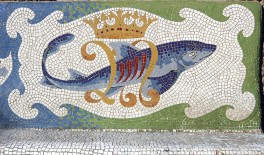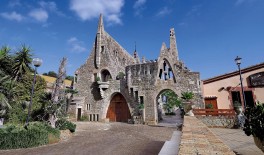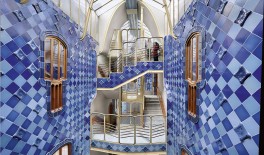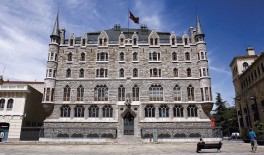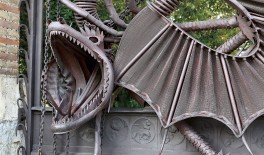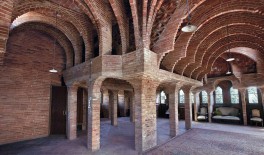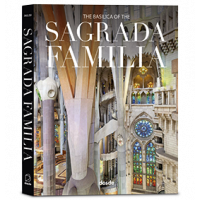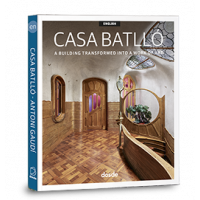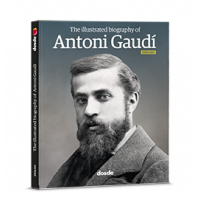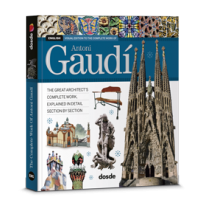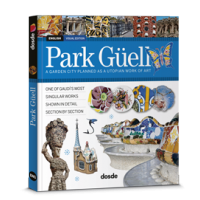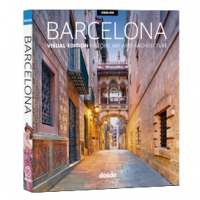The complete work of Antoni Gaudí
The most innovative and revolutionary architect of all time
RETURN
About the book The complete work of Gaudí
This book dedicated to Antoni Gaudí works is a comprehensive look at the artist's legacy, analysing in depth the origins, the structure and the significance of his most emblematic projects and delving into the iconography characteristic of an artist that always stood out for his ability to combine functionalism and symbolism.
This book published by Dosde constitutes one of the most complete compilations of Antoni Gaudí works during his career as an architect, from the very first Antoni Gaudí buildings in Barcelona to the works that established him as an architect and that put him at the forefront of his time.This book forms part of the Architectural Series and has been published within the genre of a Deluxe Edition, which means that it is an edition that has a wealth of information and photographs, which provide a better appreciation of Antoni Gaudí works.
Structured around architectonic styles, the book outlines the main projects of each trend, its elements and details, as well as the materials and structures devised by Gaudí. This way, the book allows a close look at the works of this exceptional architect from a brand new perspective.
This book published by Dosde constitutes one of the most complete compilations of Antoni Gaudí works during his career as an architect, from the very first Antoni Gaudí buildings in Barcelona to the works that established him as an architect and that put him at the forefront of his time.This book forms part of the Architectural Series and has been published within the genre of a Deluxe Edition, which means that it is an edition that has a wealth of information and photographs, which provide a better appreciation of Antoni Gaudí works.
Structured around architectonic styles, the book outlines the main projects of each trend, its elements and details, as well as the materials and structures devised by Gaudí. This way, the book allows a close look at the works of this exceptional architect from a brand new perspective.
Deluxe Edition
The complete work of Antoni Gaudí
It includes exclusive digital content
Multilanguage: Available in 6 languages
Made with environmentally friendly paper
More than 180 top quality photographs
About the book The complete work of Gaudí
This book dedicated to Antoni Gaudí works is a comprehensive look at the artist's legacy, analysing in depth the origins, the structure and the significance of his most emblematic projects and delving into the iconography characteristic of an artist that always stood out for his ability to combine functionalism and symbolism.
This book published by Dosde constitutes one of the most complete compilations of Antoni Gaudí works during his career as an architect, from the very first Antoni Gaudí buildings in Barcelona to the works that established him as an architect and that put him at the forefront of his time.This book forms part of the Architectural Series and has been published within the genre of a Deluxe Edition, which means that it is an edition that has a wealth of information and photographs, which provide a better appreciation of Antoni Gaudí works.
Structured around architectonic styles, the book outlines the main projects of each trend, its elements and details, as well as the materials and structures devised by Gaudí. This way, the book allows a close look at the works of this exceptional architect from a brand new perspective.
This book published by Dosde constitutes one of the most complete compilations of Antoni Gaudí works during his career as an architect, from the very first Antoni Gaudí buildings in Barcelona to the works that established him as an architect and that put him at the forefront of his time.This book forms part of the Architectural Series and has been published within the genre of a Deluxe Edition, which means that it is an edition that has a wealth of information and photographs, which provide a better appreciation of Antoni Gaudí works.
Structured around architectonic styles, the book outlines the main projects of each trend, its elements and details, as well as the materials and structures devised by Gaudí. This way, the book allows a close look at the works of this exceptional architect from a brand new perspective.
Videos The complete work of Antoni Gaudí
Readers opinions
(19)
RETURN
Reviews
(19)
Very good photos, good book.
High quality and very complete books.
Very rigorous content, I liked it a lot.
The content seems to be of a high quality and it deals with the subject in depth.
Excellent photos and a lot of information about Gaudí's works.
A very complete book, with great photographs and content. It's an excellent complement to remember the trip.
Recommendable. A very good book, with photographs and high quality illustrations.
A great book! His story and works with excellent pictures
The book gives each theme in-depth treatment and goes into great detail about Gaudí's work. I regard it as a quality work, carefully produced and complete.
Good illustrations, which you don't usually find in these types of books.
The cover immediately caught my attention and I saw that the content was very complete and detailed. It is a beautifully published book.
It seemed to be a very complete book to get to know Gaudí and his work better.
It was worth buying this book, it was just what I was looking for.
Good photos, great content with in-depth detail. It's been a good buy.
Very good photos, good book.
I really liked the content of the book, very interesting.
I liked the book a lot, a great buy!
The book totally lived up to my expectations, it was well worth buying.
I'm amazed at how complete the book is
Readers opinions
(19)
Additional Information
- Additional Information
- Subtitle: The most innovative and revolutionary architect of all time
- Weight (g): 1235
- Binding: Hard cover
- Size (cm): 26,5 x 26,5
- Author: Dosde
- Pages: 0
- Edition: Deluxe Edition
Antoni Gaudí works
Considered one of the most important architects in history, Antoni Gaudí was ahead of his time creating an artistic language that was both surprising and unique, which took its inspiration from nature. The most evident testimony of Gaudí's creativity as an architect are his works, renowned and admired throughout the world for their imaginative and innovative character.
The creator of Sagrada Familia already showed his genius in early commissions, such as Casa Vicens, the Caprice and Güell Palace, devised under the influence of Historicism, though his style was perfected on with the passing of time, as is reflected in his mature works, which include Casa Batlló, la Pedrera and Park Güell.
The relationship between Gaudí and the Sagrada Familia goes back to the architect's early days, while Güell Palace, the Teresian College, Casa Vicens and the Torre Bellesguard were planned around the late 19th century and the early 20th century, when Gaudí was already beginnning to make a name for himself in the city.
Gaudí’s most important works in Barcelona belong to his mature period, and demonstrate the key role that nature played in his work. Amongst these projects are Park Güell, which the architect couldn't finish due to a lack of financial support, Casa Batlló and La Pedrera, also known as Casa Milá, the only Antoni Gaudí buildings on Passeig de Gràcia.
After these works, which have now become international architectural icons of Barcelona, Gaudí focused exclusively on the Sagrada Familia, the work in which the architect would incorporate all the constructive and symbolic resources that he had developed from the beginnings of his professional career. Conceived as the perfect Christian temple, the basilica is the most obvious example of Gaudí's creative audacity, despite the fact that the architect died when only the Nativity façade had been erected.
In the early 20th century, Gaudí also participated in the refurbishment of the Cathedral of Mallorca and designed the Artigas Gardens, located in La Pobla de Lillet, a town close to the Pyrenees. The last large building of Gaudí outside Barcelona was the church in the Colonia Güell, an industrial estate that Eusebi Güell owned in Santa Coloma de Cervelló.
This temple, where only the crypt got to be built, was where Gaudí tried out some of the solutions that he would apply later on in the Sagrada Familia. Owing to its historical and artistic importance, the Güell Colony crypt is included on Unesco's World Heritage Site list, a distinction that other Gaudí works have also received, such as Park Güell, Palau Güell, La Pedrera, Casa Vicens, Casa Batlló and Sagrada Familia.
One of the first works by Gaudí in Barcelona was the creation of the hydraulic project for the monumental fountain in Ciudadela Park. The architect, who was still a student, worked alongside Josep Fontserè, who also sought Gaudí's skills for the design of the railing of the park, one of the most popular spaces of 19th century Barcelona.
In 1878, just after graduating as an architect, Gaudí received the commission from the City Council to design lamp posts for Plaça Reial, in the city centre. Still standing in the square, the lamp posts received good reviews from the press and the locals and helped spread the architect's name.
Also in 1878 Gaudí started designing a housing development and installations for the Obrera Mataronense, a co-operative society dedicated to textile manufacture. Finally, the only building that got to be constructed was a laundry room, in which Gaudí used his characteristic parabolic arches.
In 1895, Gaudí received a commission from his patron, Eusebi Güell, to construct a winery in the Barcelonan locality, Garraf. With the help of Francesc Berenguer, the architect planned a medieval style building, which blended in perfectly with its surroundings.
The catalogue of the lesser known Gaudí works also includes the entrance way to the property Finca Miralles, the Catllaràs chalet and the Schoolrooms that are alongside the Sagrada Familia, buildings that still can be visited, in contrast to the Arab room of the Bar Torino, the Torre de La Miranda and the lamp posts that were in the Plaza Mayor in a town called Vic, which disappeared over time.
The creator of Sagrada Familia already showed his genius in early commissions, such as Casa Vicens, the Caprice and Güell Palace, devised under the influence of Historicism, though his style was perfected on with the passing of time, as is reflected in his mature works, which include Casa Batlló, la Pedrera and Park Güell.
Antoni Gaudí buildings in Barcelona
Originally from Reus, Gaudí moved during his adolescence to Barcelona in order to complete his studies and it was in this city where he embarked on his architectural degree and carried out most of his projects. The early Antoni Gaudí works in Barcelona include Casa Vicens and Finca Güell, two buildings that show the architect's interest to incorporate resources from Islamic art into his own artistic language.The relationship between Gaudí and the Sagrada Familia goes back to the architect's early days, while Güell Palace, the Teresian College, Casa Vicens and the Torre Bellesguard were planned around the late 19th century and the early 20th century, when Gaudí was already beginnning to make a name for himself in the city.
Gaudí’s most important works in Barcelona belong to his mature period, and demonstrate the key role that nature played in his work. Amongst these projects are Park Güell, which the architect couldn't finish due to a lack of financial support, Casa Batlló and La Pedrera, also known as Casa Milá, the only Antoni Gaudí buildings on Passeig de Gràcia.
After these works, which have now become international architectural icons of Barcelona, Gaudí focused exclusively on the Sagrada Familia, the work in which the architect would incorporate all the constructive and symbolic resources that he had developed from the beginnings of his professional career. Conceived as the perfect Christian temple, the basilica is the most obvious example of Gaudí's creative audacity, despite the fact that the architect died when only the Nativity façade had been erected.
Antoni Gaudí works outside Barcelona
The first important commission that Gaudí worked on outside Barcelona was the Caprice, located in the Cantabrian town Comillas. This house of Oriental influence was built for Máximo Díaz de Quijano, a lawyer that had made his fortune in America. In the province of León, Gaudí planned the Episcopal Palace of Astorga, whose design shows the influence of medieval castles, and Casa Botines, at present one of the key places to visit in the city of León.In the early 20th century, Gaudí also participated in the refurbishment of the Cathedral of Mallorca and designed the Artigas Gardens, located in La Pobla de Lillet, a town close to the Pyrenees. The last large building of Gaudí outside Barcelona was the church in the Colonia Güell, an industrial estate that Eusebi Güell owned in Santa Coloma de Cervelló.
This temple, where only the crypt got to be built, was where Gaudí tried out some of the solutions that he would apply later on in the Sagrada Familia. Owing to its historical and artistic importance, the Güell Colony crypt is included on Unesco's World Heritage Site list, a distinction that other Gaudí works have also received, such as Park Güell, Palau Güell, La Pedrera, Casa Vicens, Casa Batlló and Sagrada Familia.
The lesser known Gaudí works
Projects such as the Sagrada Familia and La Pedrera have somewhat put Gaudí's lesser known works in the shade, some of which have disappeared over time. Despite the fact that these projects aren't well known, these commissions were also a fine example of the architect's ingenuity, who also made the most of his more modest works to put into practice his imaginative constructive solutions.One of the first works by Gaudí in Barcelona was the creation of the hydraulic project for the monumental fountain in Ciudadela Park. The architect, who was still a student, worked alongside Josep Fontserè, who also sought Gaudí's skills for the design of the railing of the park, one of the most popular spaces of 19th century Barcelona.
In 1878, just after graduating as an architect, Gaudí received the commission from the City Council to design lamp posts for Plaça Reial, in the city centre. Still standing in the square, the lamp posts received good reviews from the press and the locals and helped spread the architect's name.
Also in 1878 Gaudí started designing a housing development and installations for the Obrera Mataronense, a co-operative society dedicated to textile manufacture. Finally, the only building that got to be constructed was a laundry room, in which Gaudí used his characteristic parabolic arches.
In 1895, Gaudí received a commission from his patron, Eusebi Güell, to construct a winery in the Barcelonan locality, Garraf. With the help of Francesc Berenguer, the architect planned a medieval style building, which blended in perfectly with its surroundings.
The catalogue of the lesser known Gaudí works also includes the entrance way to the property Finca Miralles, the Catllaràs chalet and the Schoolrooms that are alongside the Sagrada Familia, buildings that still can be visited, in contrast to the Arab room of the Bar Torino, the Torre de La Miranda and the lamp posts that were in the Plaza Mayor in a town called Vic, which disappeared over time.

